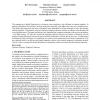Free Online Productivity Tools
i2Speak
i2Symbol
i2OCR
iTex2Img
iWeb2Print
iWeb2Shot
i2Type
iPdf2Split
iPdf2Merge
i2Bopomofo
i2Arabic
i2Style
i2Image
i2PDF
iLatex2Rtf
Sci2ools
WSCG
2003
2003
Dynamic Radiosity using Higher Order Functions Bases and Temporal Coherence
The computation of global illumination in a dynamic scene constitutes a real challenge in computer graphics. In radiosity algorithms, this problem is far from being easy, especially when light sources move in a complex scene. This subject becoming more and more widespread, many algorithms have been presented to solve the dynamic radiosity problem. Unfortunately, none uses intensive temporal coherence and few are efficient when dealing with a moving light source. This paper introduces a new algorithm that computes animations with any moving surfaces - even light sources. We take into account the temporal coherence between two frames to determine only the luminous energy differences between the previous global illumination solution and the new one. A mathematical development of the form factor for a translation or a rotation avoids unnecessary form factors computations. This new approach leads to an efficient and simple algorithm, similar to the classical progressive refinement metho...
| Added | 01 Nov 2010 |
| Updated | 01 Nov 2010 |
| Type | Conference |
| Year | 2003 |
| Where | WSCG |
| Authors | Venceslas Biri, Sylvain Michelin, Didier Arquès |
Comments (0)

